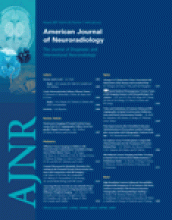Abstract
BACKGROUND AND PURPOSE: Little is known about the metabolic properties of brain edema associated with tumors. This work was conducted on the basis of the assumption that, in the presence of intra-axial and extra-axial brain tumors, the white matter involved by the edema is a site of metabolic change that involves the structure of the myelin sheath.
MATERIALS AND METHODS: Thirteen patients comprised our cohort affected by intra-axial and extra-axial cerebral tumors with a peritumoral T2-weighted MR signal hyperintensity as a result of edema, where MR spectroscopy showed no increase in choline-containing compounds. Measurements on proton MR spectroscopy (1H-MR spectroscopy) were performed with a 3T whole-body scanner with use of a point-resolved spectroscopy sequence for localization (TR, 2000 ms; TE, 35 ms), and the metabolites were quantified with the SAGE method. Peak intensities of the main metabolites were expressed as ratios of one another and were compared with values obtained in the white matter of the left frontal region in a control group of 16 healthy volunteers.
RESULTS: Choline-to-creatine (Cho/Cr) and myo-inositol-to-creatine (mIns/Cr) signal intensity ratios were normal in all patients. N-acetylaspartate-to-creatine (NAA/Cr) and N-acetylaspartate-to-choline (NAA/Cho) ratios decreased in 4 patients. Glutamate plus glutamine-to-creatine (Glx/Cr) was increased in 10 patients. A resonance peak at 3.44 ppm, strongly suggesting the presence of glucose, was detected in all but 1 patient. Lactate was detected in 12 patients and lipids in 5. Moreover, the resonances that pertained to the aliphatic amino acids valine, leucine, and isoleucine were present in 12 patients.
CONCLUSIONS: Our findings on MR spectroscopy confirmed the hypothesis that in the edema surrounding brain tumors, an energy-linked metabolic alteration was associated with injury to the myelin sheath.
- Copyright © American Society of Neuroradiology












